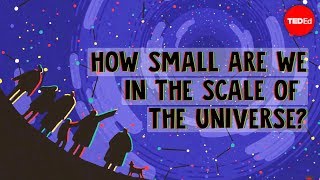(单词翻译:单击)
In the winter of 1995, scientists pointed the Hubble Telescope at an area of the sky near the Big Dipper,
1995年的冬天,科学家们将哈勃望远镜对准了北斗七星附近的一片天空,
a spot that was dark and out of the way of light pollution from surrounding stars.
那是一片漆黑、远离周围恒星的光污染。
The location was apparently empty, and the whole endeavor was risky.
这个区域似乎空无一物,所有的努力都有可能白费。
What, if anything, was going to show up?
但如果那个区域真的有东西,那会是什么呢?
Over ten consecutive days, the telescope took close to 150 hours of exposure of that same area.
在接下来的十天里,哈勃望远镜对这片区域进行了150小时的持续曝光。
And what came back was nothing short of spectacular:
而得到的图像令人惊叹:
an image of over 1,500 distinct galaxies glimmering in a tiny sliver of the universe.
1500多个各不相同的星系,在这宇宙的一角闪耀着。
Now, let's take a step back to understand the scale of this image.
现在,让我们倒回来,认识下这张图像的真实大小。
If you were to take a ballpoint pen and hold it at arm's length in front of the night sky,
假设你站在夜空前,将一支圆珠笔举在一臂远的位置,
focusing on its very tip, that is what the Hubble Telescope captured in its first Deep Field image.
注视它的最远端,这就是哈勃望远镜拍摄到的第一张哈勃深空视场。
In other words, those 3,000 galaxies were seen in just a tiny speck of the universe,
换句话说,这3000个星系只是宇宙里的一点尘埃,
approximately one two-millionth of the night sky.
大约占全部星空的两百万分之一。
To put all this in perspective, the average human measures about 1.7 meters.
更直观地来理解,人类平均身高约1.7米。
With Earth's diameter at 12,700 kilometers, that's nearly 7.5 million humans lined up head to toe.
而地球的直径是12700公里,大约是750万人头脚相连的长度。
The Apollo 8 astronauts flew a distance of 380,000 kilometers to the moon.
阿波罗8号宇航员需要飞行38万公里才能到达月球。
And our relatively small Sun has a diameter of about 1.4 million kilometers, or 110 times the Earth's diameter.
而我们的太阳,作为一颗相对较小的恒星,直径也有140万公里,也就是地球直径的110倍。
A step further, the Milky Way holds somewhere between 100 to 400 billion stars, including our Sun.
更进一步,银河系包含约1000到4000亿颗恒星,其中包括我们的太阳。

And each glowing dot of a galaxy captured in the Deep Field image contains billions of stars at the very least.
而哈勃深空里拍到的每一个闪耀的星系都包含着至少十亿颗恒星。
Almost a decade after taking the Deep Field image,
在拍摄了哈勃深空的大约十年后,
scientists adjusted the optics on the Hubble Telescope and took another long exposure over a period of about four months.
科学家们调整了哈勃望远镜的镜片,又进行了长达4个月的长曝光。
This time, they observed 10,000 galaxies.
这一次,他们观测到了一万个星系。
Half of these galaxies have since been analyzed more clearly in what's known as the eXtreme Deep Field image, or XDF.
这其中一半的星系自此得到了更清楚的分析,而这张照片就是“哈勃极端深空”,即XDF。
By combining over ten years of photographs,
结合十多年的图片,
the XDF shows galaxies so distant that they're only one ten-billionth the brightness that the human eye can perceive.
XDF展示的星系是如此遥远,它们的亮度只有人眼可感知的百亿分之一。
So, what can we learn about the universe from the Deep Field images?
所以,从哈勃深空图像里,我们对宇宙有哪些新认识?
In a study of the universe, space and time are inextricably linked.
在宇宙学研究中,空间和时间密不可分。
That's because of the finite speed of light.
这是因为光速是有限的。
So the Deep Field images are like time machines to the ancient universe.
所以,哈勃深空图像就像是通往远古宇宙的时光隧道。
They reach so far into space and time that we can observe galaxies that existed over 13 billion years ago.
这些图片深入空间和时间,让我们观测到130多亿年前的星系。
This means we're looking at the universe as it was less than a billion years after the Big Bang,
这意味着我们看到的宇宙存在于大爆炸后不到10亿年间,
and it allows scientists to research galaxies in their infancy.
而科学家们则有机会研究星系的幼年期。
The Deep Field images have also shown that the universe is homogeneous.
哈勃深空还体现了宇宙是各向同性的。
That is, images taken at different spots in the sky look similar.
也就是,夜空中不同区域拍摄到的图像是类似的。
That's incredible when we think about how vast the universe is.
考虑到宇宙是多么得浩瀚无垠,这简直难以置信。
Why would we expect it to be the same across such huge distances?
莫非跨越如此巨大距离的宇宙是一致的?
On the scale of a galaxy, let alone the universe, we're smaller than we can readily comprehend,
我们比自己想象的更渺小,仅仅是与星系对比,更遑论宇宙。
but we do have the capacity to wonder, to question, to explore, to investigate, and to imagine.
但是我们有能力去思考,去质疑,去探索,去调查,去想象。
So the next time you stand gazing up at the night sky,
所以,当你下次仰望星空时,
take a moment to think about the enormity of what is beyond your vision, out in the dark spaces between the stars.
不如花点时间想象一下,那些在你视线之外、深埋于繁星之间的漆黑,其实是如此的浩瀚深邃。


